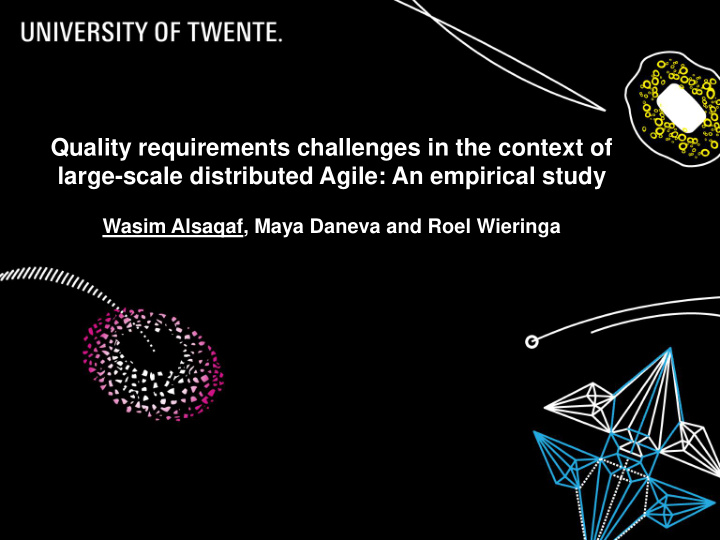



Quality requirements challenges in the context of large-scale distributed Agile: An empirical study Wasim Alsaqaf, Maya Daneva and Roel Wieringa
TABLE OF CONTENTS Introduction Research Question Research Process Results Key Learning and implications Threats of validity Conclusions REFSQ2018 26/3/18 2
INTRODUCTION AGILE & QUALITY REQUIREMENTS (NON-FUNCTIONAL REQUIREMENTS) Agile methods became increasingly popular the last years A recent SLR* on Agile found that Agile development methods neglect the Quality requirements in Agile methods* during the development cycle Undermine the profits of fast delivery by introducing high rework efforts later on Distributed agile projects could suffer more because of the neglect of QRs * I. Inayat, L. Moraes, M. Daneva , and S. S. Salim, “A Reflection on Agile Requirements Engineering: Solutions Brought and Challenges Posed,” in XP Workshops, 2015. REFSQ2018 26/3/18 3
INTRODUCTION OUR RESEARCH In response to that problem, we initiated an empirical research project to develop best practices to help agile practitioners identifying, implementing and testing QRs in distributed agile projects. identify the challenges that agile practitioners face concerning QRs REFSQ2018 26/3/18 4
RESEARCH QUESTION What are the challenges Agile practitioners face when engineering the QRs in distributed large- scale settings? REFSQ2018 26/3/18 5
RESEARCH PROCESS QUALITATIVE EXPLORATORY MULTI-CASE STUDY We have followed the methodological guidelines described by R. Yin.* Semi-structured open-ended in-depth interviews Interview protocol – developed by the first author and validated by the senior researchers (the other two authors). A pilot interview is conducted (interview was not included in the result) Finalizing the interview questions** * R. K. Yin, Case Study Research Design and Methods, 5th Revise. Sage Publications Inc, 2013. ** https://wasimalsaqaf.files.wordpress.com/2017/07/interviewquestions.docx REFSQ2018 26/3/18 6
RESEARCH PROCESS INVOLVED ORGANIZATIONS Size in employee’s number Organization # of projects # of participants Middle (51 – 200) O1 2 4 Middle (51 – 200) O2 1 2 Big (200 – 500) O3 1 1 Big (300 – 700) O4 3 3 Big (10000 – 30000) O5 3 3 Big (50.000 – 100.000 ) O6 4 4 REFSQ2018 26/3/18 7
RESEARCH PROCESS INVOLVED PARTICIPANTS Between 4 – 36 years of experience Different roles & background (developer, architect, tester, scrum master, etc.) Different domains (Public sector, government, banking, commercial etc.) REFSQ2018 26/3/18 8
RESULTS Teams coordination and communication challenges Late detection of QRs infeasibility Assumptions in inter-team collaboration Uneven teams maturity Suboptimal inter-team organization Quality Assurance challenges Inadequate QRs test specification Simulated integration tests End user acceptance of QRs REFSQ2018 26/3/18 9
RESULTS QRs elicitation challenges Overlooking sources of QRs Lack of QRs visibility Conceptual challenges of QRs Conceptual definition of QRs Mixed specification approaches to QRs Architecture challenges Unmanaged architecture changes Misunderstanding the architecture drivers REFSQ2018 26/3/18 10
DISCUSSION COMPARISON WITH PREVIOUS EMPIRICAL STUDIES What challenges did we find, that were not mentioned before? Insufficient inter-team collaboration, Organizing distributed teams around the product backlog in a sufficient way Lack of visibility of QRs early in the project and Knowledge and skills discrepancy within a single team / teams REFSQ2018 26/3/18 11
DISCUSSION COMPARISON WITH PREVIOUS EMPIRICAL STUDIES What was already discussed in prior studies? QRs identification and documentation difficulties Focusing on delivering functionality at the cost of architecture flexibility Ignoring predictable architecture requirements, Insufficient requirements analysis, Validating QRs occurs too late in the process and Product Owner’s lack of knowledge REFSQ2018 26/3/18 12
DISCUSSION COMPARISON WITH PREVIOUS EMPIRICAL STUDIES What was already discussed in prior studies but not found in this study? Product Owner’s heavy workload and Insufficient availability of the Product Owner REFSQ2018 26/3/18 13
KEY LEARNING AND IMPLICATIONS (1/2) Practitioners struggle with the nature of QRs Are user stories equivalent to traditional requirements or not? 3C = Card (written user story), Conversation (user story discussion) and Confirmation (user story acceptance criteria) REFSQ2018 26/3/18 14
KEY LEARNING AND IMPLICATIONS (1/2) Our suggestions: Practitioners should think carefully at the beginning of a project about how to treat the QRs Organizing distributed teams should happen in a way that ensure the streaming of tacit knowledge from the more knowledgeable to the novices REFSQ2018 26/3/18 15
THREATS OF VALIDITY The first author is an agile practitioner, so occupational bias is possible. Involved practitioners may not answer the question honestly. The interviewer may ask leading questions REFSQ2018 26/3/18 16
CONCLUSION Thirteen main challenges were identified regarding QRs based on a qualitative exploratory case study. There is actually a conceptual problem when it comes to the identification of QRs. We think that the challenges are not caused by Agile methods but by the way practitioners implement those methods REFSQ2018 26/3/18 17
THANK YOU For additional questions/information → w.h.a.alsaqaf@utwente.nl REFSQ2018 26/3/18 18
Recommend
More recommend